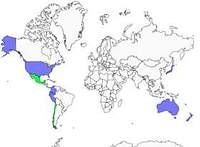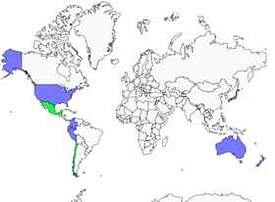Juan Fernandez Petrel
Pterodroma externa - Pétrel de Juan Fernandez
Identification
It is a fairly large Juan Fernandez Petrel and looks similar to several other Pterodroma, making it difficult to distinguish. The distinctive features are visible from the underside: very white undersides of the wings with only a small blackish carpal stroke that does not reach the center of the wing, a narrow dark trailing edge and a well contrasted black wingtip formed by the tips of the outer remiges. The dark eye is set within a darker area of the cap and separated by a clear line from a fairly faint breast band.
Subspecific information monotypic species
Foreign names
- Pétrel de Juan Fernandez,
- Petrel de las Juan Fernández,
- freira-grande-das-juan-fernández,
- Robinsonsturmvogel,
- Juan Fernández-szigeti viharmadár,
- Witnekstormvogel,
- Petrello di Juan Fernandez,
- juanfernándezpetrell,
- Juanfernandezpetrell,
- tajfúnnik Salvinov,
- buřňák ostrovní,
- Juan Fernandez-petrel,
- chilenviistäjä,
- petrell de l'illa Juan Fernández,
- petrel wędrowny,
- Белошейный тайфунник,
- オオシロハラミズナギドリ,
- 白颈圆尾鹱,
- juanfernándezpetrell,
- 斐南德斯白頸圓尾鸌,
Habitat
The species is highly pelagic outside of its breeding season.
Dietfeeding habits
It feeds on fish, molluscs, or even pelagic hemipterans such as Halobates. It captures them from the surface or when diving.
Reproduction nesting
The species nests on grassy slopes, at 600-1,000 metres of altitude, either in a burrow or under a tuft. The breeding season spans from October to June and its development is barely known. It seems that the female only lays one white egg.
Geographic range
The Juan Fernandez Petrel species breeds in the Juan Fernandez Archipelago located off the center of Chile in the east Pacific. It then frequents the peripheral waters. But outside this period, like all pelagic birds, it visits other waters, going beyond the equator to the north. It mainly sails the central Pacific, but has already been spotted as far as the coastline of Mexico where it may be the most common Pterodroma and even off the coast of Japan.
Threats - protection
IUCN conservation status
concern
in the Wild
threatened
evaluated
The species is classified as vulnerable, despite an estimated population of 3 million individuals and no apparent decline, probably due to its restricted reproductive sites.
Sources of information
- IOC World Bird List (v15.1), Gill, F and D Donsker (Eds). 2025-12-07.
- Avibase, Lepage Denis
- HBW Alive,
Other sources of interest
 Specification sheet created on
28/07/2023 by Jean François
Specification sheet created on
28/07/2023 by Jean FrançoisTranslation by AI Oiseaux.net
© 1996-2025 Oiseaux.net
- Accipitriformes
- Aegotheliformes
- Anseriformes
- Apodiformes
- Apterygiformes
- Bucerotiformes
- Caprimulgiformes
- Cariamiformes
- Casuariiformes
- Charadriiformes
- Ciconiiformes
- Coliiformes
- Columbiformes
- Coraciiformes
- Cuculiformes
- Eurypygiformes
- Falconiformes
- Galliformes
- Gaviiformes
- Gruiformes
- Leptosomiformes
- Mesitornithiformes
- Musophagiformes
- Nyctibiiformes
- Opisthocomiformes
- Otidiformes
- Passeriformes
- Pelecaniformes
- Phaethontiformes
- Phoenicopteriformes
- Piciformes
- Podargiformes
- Podicipediformes
- Procellariiformes
- Psittaciformes
- Pterocliformes
- Rheiformes
- Sphenisciformes
- Steatornithiformes
- Strigiformes
- Struthioniformes
- Suliformes
- Tinamiformes
- Trogoniformes





